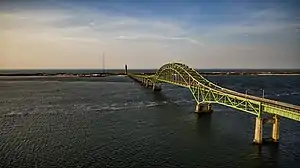Fire Island Inlet Bridge | |
|---|---|
 Fire Island Inlet Bridge | |
| Coordinates | 40°37′56″N 73°15′46″W / 40.6322°N 73.2628°W |
| Carries | |
| Crosses | Fire Island Inlet |
| Characteristics | |
| Material | Steel |
| Width | 2 lane |
| History | |
| Construction cost | $10 million |
| Opened | 1964 |
| Location | |
The Fire Island Inlet Bridge, an integral part of the Robert Moses Causeway, is a two-lane, steel tied arch span with a concrete deck that carries the parkway over Fire Island Inlet.
Construction of the Fire Island Bridge was completed in 1964 and although a relatively young structure, (less than 60 years old), its concrete deck has suffered from severe chloride ingress resulting in cracks, spalling, and the formation of potholes.[1]
The Fire Island Inlet span of the Robert Moses Causeway connects to Robert Moses State Park on the western tip of Fire Island.
The Fire Island Inlet Bridge is located south of the State Boat Channel Bridge, a 665-foot (203 m) long bascule bridge modeled after Brooklyn's Mill Basin Drawbridge.
History

The Fire Island Inlet span cost $10 million to complete and opened to traffic on June 13, 1964.[2][3] By 1985, a dual span was supposed to be built to alleviate traffic; the second bridge proposal was never implemented.[4] As first proposed in 1938, the span was to be a vertical-lift span with a design similar to that of the Marine Parkway–Gil Hodges Memorial Bridge. The design was changed to conform with that of the Great South Bay Bridge, a 600-foot (180 m) steel-arch span with a 60-foot (18 m) clearance.[4]
In 2004, the New York State Department of Transportation began studies on the Fire Island Inlet span after the realization that it was rapidly decomposing due to flaws in the cement during its construction.[4][5] A 5-short-ton (4,500 kg) weight restriction was enforced by local police until permanent repairs could be made.[6]
Currently repairs are being undertaken to extend the life and safety of the bridge; groundbreaking for a new bridge was expected in 2010. It is assumed that the new bridge will be built to the west of the current structure; the new span will be four lanes, two southbound and two northbound. The new Fire Island Bridge will keep the look of the old one for aesthetic conformity with the other bridges over the bay.
References
- ↑ "Robert Moses Causeway" (PDF). Stirling Lloyd. Retrieved 2010-04-11.
- ↑ Porterfield, Byron (June 4, 1964). "$10 Million Fire Island Bridge To Be Opened to Public June 13". The New York Times. p. 39. Retrieved 2010-04-11.
- ↑ Maiorana, Ronald (June 14, 1964). "New L.I. Bridge Opened By Moses". The New York Times. p. 82. Retrieved 2010-04-11.
- 1 2 3 Anderson, Steve. "Robert Moses Causeway". NYCRoads. Retrieved 2010-04-11.
- ↑ Constantino, Frank (February 2004). "New York Stretches Bridge Deck Life". Better Roads. 74 (2): 98–99. Archived from the original on 17 April 2004. Retrieved 11 June 2014.
- ↑ "Featured Project: Gusset Plate Replacement Robert Moses Causeway over Fire Island Inlet, BIN 1058770" (PDF). Bridge Maintenance News. 2 (6): 1. November 2009. Retrieved 2011-11-05.